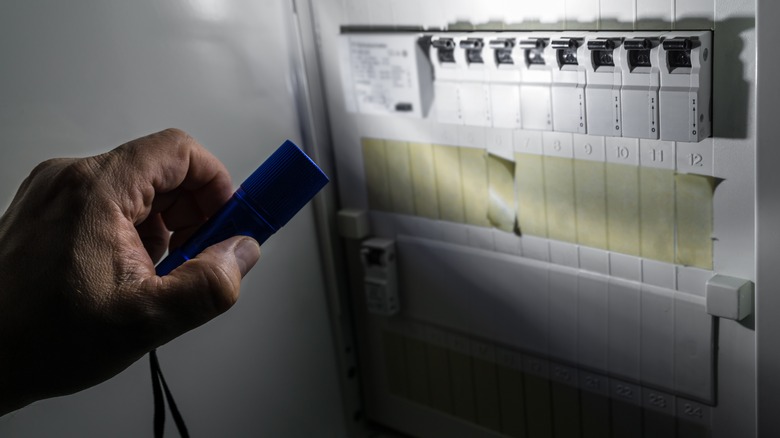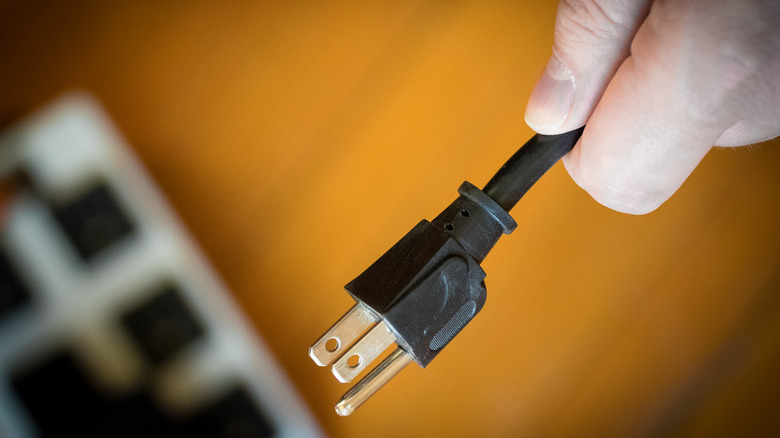Are You Supposed To Unplug Electronics In A Power Outage?
Power outages and "brownouts" can be both frustrating and inconvenient to wait out. In 2019, Americans nationwide were without power for a cumulative average of 4.7 hours; this according to data from the U.S. Energy Information Administration's annual survey and report (via Cummins). During those outages, exactly how many of us went and unplugged our electronics while waiting for the power to return? You may have heard some guidance somewhere, at some time, advising you to do so during a power outage, but the question is, is this really necessary, and if so, why?
It might feel bothersome to run around the house or office, disconnecting and unplugging all the devices, but it's actually a smart thing to do, says Constellation Energy, because wavering voltages and surges can damage electronics and appliances, rendering them useless even upon full restoration of electricity. Power outages, brownouts, and surges occur for several reasons, including storms, grid failure, and electromagnetic pulses (EMTs), according to Penny Electric.
With any electric issue, always check whether the problem is exclusive to your home or is widespread. As for unplugging your electronics and appliances, here's more on that and why doing so is recommended — even if you've been fortunate enough not to experience any damage from past power outages yourself.
Electronics and their vulnerability to power surges and spikes
During a full power outage, power to devices abruptly stops, which is not when potential harm actually occurs. The problem is when power is restored; this is when a surge can happen and result in irreparable damage. Black Diamond Plumbing describes a power surge as lasting for a short duration; when it happens, there's a brief increase to the household's current. A power spike, meanwhile, is a sudden, immediate, and intense burst(s) of electricity. Both are potentially bad for any device that remains plugged into a power source during an outage. Because of this, it makes sense to unplug items that would be expensive to replace, such as TVs, game consoles, computers, and single-room air conditioning units.
While large appliances like washers, dryers, freezers, and stoves are also susceptible to surge damage, unplugging them may be too difficult (but there are things you can do to avoid problems with these items). Additionally, switching furnace and central air conditioning units to "OFF" is advised because their electrical components can easily be damaged when power resumes, says Custom Air & Plumbing.
It's also important to note that this action is recommended after an outage or brownout but not during a voltage sag, which according to Appliance Parts Pros, occurs when there is a rapid, brief demand on the electrical system due to an appliance, such as a vacuum cleaner, being turned on. A power sag may cause lights to flicker momentarily or appliances to lag until the draw on the system ends.
Preparation can save your electronics
According to Haven Home Tech, internal power surges happen daily on average about 220 times. Besides regular electrical wiring, surges and spikes can travel along any wiring, including coaxial cables, phone cords, Ethernet cables, and cable and satellite connections. Prevent the untimely demise of your electronic devices by unplugging them and using surge protectors. In fact, CMC Service Experts recommends whole-house surge protection for the ultimate peace of mind. Upgraded Home says the cost of such systems starts at around $500 and increases with home size. These should most likely be installed by a professional electrician.
With this said, you can protect your devices without whole-house protection. As Lowe's explains, for home entertainment systems and office equipment, you can go with a surge protector (designed to absorb and channel excess voltage away from devices connected to them) with connection points for these types of cables and cords. Further, although the products look similar, basic power strips and multi-plug adapters offer no surge protection. The packaging will distinguish the product's ability to absorb excess power by listing joules and voltage ratings, per Lowe's.
Penny Electric also advises using surge protectors, especially for large appliances. Most devices can be plugged into a mountable surge protector or the corded kind, which looks like a power strip. There are also energy-saving and remote control operated surge protectors available.


